When we say “how are capacitors rated,” we’re referring to the specific characteristics and performance metrics assigned to capacitors. These ratings provide essential information about how capacitors behave and what conditions they can handle in electronic circuits.
Capacitors Types
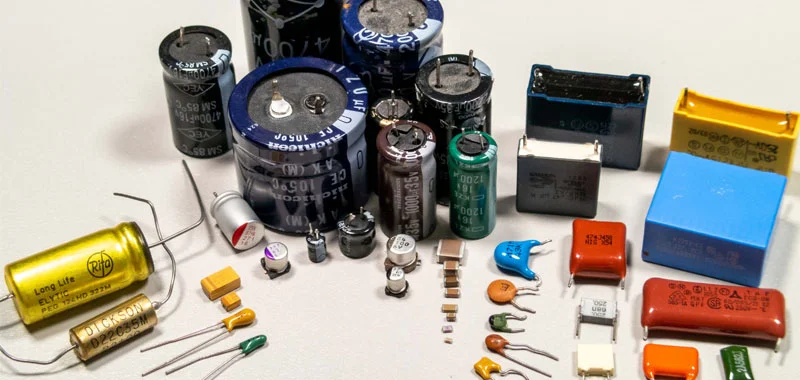
| Type | Dielectric Material | Characteristics | Applications |
|---|---|---|---|
| Ceramic Capacitors | Ceramic | Non-polarized, small size, low cost, good high-frequency performance | General-purpose use, decoupling, filtering |
| Electrolytic Capacitors | Electrolyte-soaked paper | Polarized, high capacitance values, large size, can handle higher voltages | Power supply filtering, audio applications, DC blocking |
| Tantalum Capacitors | Tantalum pentoxide | Polarized, stable, reliable, high capacitance in a small package | Space-constrained applications, decoupling, power supply filtering |
| Film Capacitors | Plastic film (e.g., polyester, polypropylene) | Non-polarized, excellent stability, low loss, good frequency characteristics | Signal coupling and decoupling, timing circuits, audio applications |
| Supercapacitors (Ultracapacitors) | Electrolyte and activated carbon | Very high capacitance can store a large amount of energy, fast charging, and discharging | Energy storage, backup power, regenerative braking systems |
| Mica Capacitors | Mica | Non-polarized, high precision, stable, low loss | RF applications, oscillators, precision timing circuits |
| Paper Capacitors | Waxed or oil-impregnated paper | Non-polarized, used in older electronic equipment, replaced by more modern types | Historical and vintage electronics |
| Glass Capacitors | Glass | Non-polarized, high stability, high-temperature tolerance, low loss | High-temperature environments, precision circuits |
| Polymer Capacitors | Conductive polymer | Polarized, stable, low ESR (Equivalent Series Resistance), high ripple current capability | Power supply circuits, computer motherboards, high-performance electronics |
How Are Capacitors Rated?
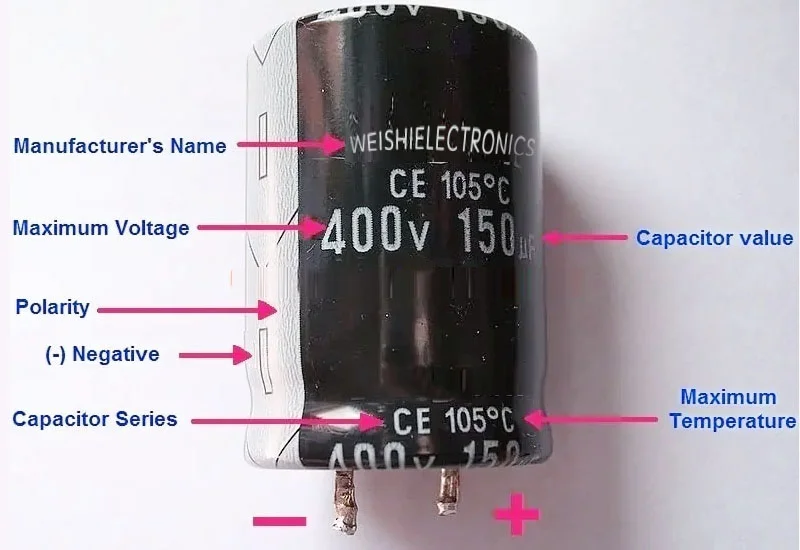
Capacitor Characteristics
Capacitors are measured through two different ratings. The first is voltage, and the second is microfarads.
Voltage Rating (V)
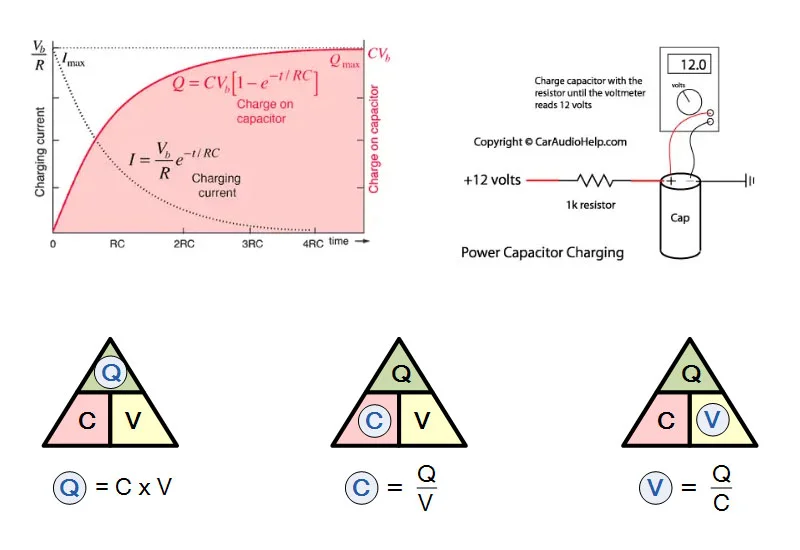
Voltage rating indicates the maximum electrical potential the capacitor can handle without risking failure. It’s analogous to water pressure in a garden hose: just as higher pressure propels water faster through the hose, higher voltage enables faster movement of electrical current. Thus, a capacitor with a higher voltage rating allows for the passage of greater electrical current.
Capacitance (C)
The second rating, capacitance, quantifies a capacitor’s ability to store electrical charge. Expressed in microfarads, it signifies the capacity of the capacitor. A higher microfarad rating indicates a greater capacity to store electrical current. Capacitors typically range from 5μF to 80μF. If denoted as µF, it represents microfarads. The rating might be indicated in this format if you can’t find it directly stated.
Capacitors are rated using several key parameters that determine their performance and suitability for specific applications. In addition to those mentioned above
Capacitance (C) and Voltage Rating (V), and several factors:
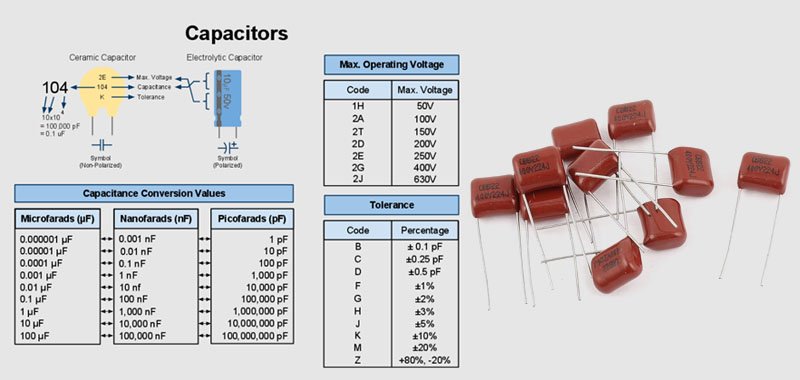
Tolerance
Like other electronic components, capacitors have a tolerance that specifies the allowable deviation from the stated nominal capacitance value. Tolerance is usually given as a percentage, such as ±5% or ±10%, indicating the range within which the actual capacitance may vary from the labeled value.
Temperature Coefficient (TC)
This parameter indicates how much the capacitance of the capacitor changes with temperature. It’s important for applications where temperature variations are significant. Temperature coefficient is typically expressed in parts per million per degree Celsius (ppm/°C) or as a percentage per degree Celsius.
Dielectric Material
Capacitors use different dielectric materials between their plates, and the choice of dielectric affects various performance characteristics such as capacitance stability, temperature coefficient, voltage rating, and frequency response. Common dielectric materials include ceramic, tantalum, aluminum electrolytic, polyester, polypropylene, and others.
Frequency Response
Capacitors behave differently at different frequencies due to their construction and dielectric material. Some capacitors are optimized for high-frequency applications, while others are better suited for low-frequency or DC applications.
ESR (Equivalent Series Resistance)
Capacitors exhibit a small amount of resistance in series with their capacitance. This resistance, known as ESR, can affect the capacitor’s performance, especially in applications like power supply filtering or decoupling.
How Are Capacitors Rated: Capacitor Colour Codes
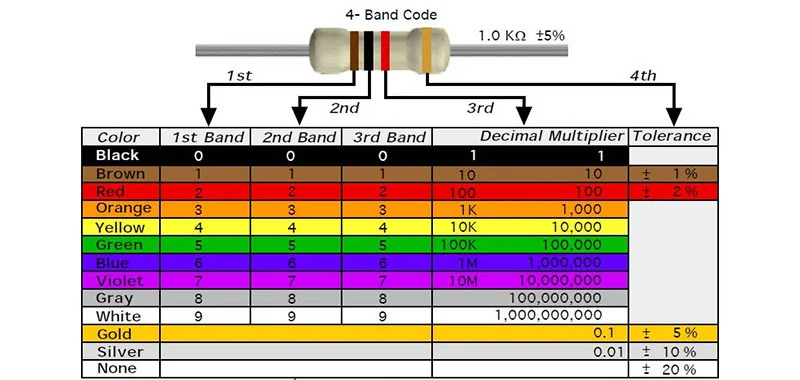
Capacitor color codes are used to indicate the capacitance value and sometimes the voltage rating of capacitors, particularly for small, non-polarized capacitors like ceramic or polyester types. These color codes follow a standardized system, similar to resistor color codes, to provide a quick and easy way to determine the capacitor’s specifications. Here’s a guide to understanding capacitor color codes:
Color Code Table for Capacitance
The color bands on a capacitor represent numbers that help determine the capacitance value. Each color corresponds to a digit, similar to the resistor color code system.
| Color | Digit | Multiplier (pF) | Tolerance |
|---|---|---|---|
| Black | 0 | ||
| Brown | 1 | 10 | ±1% |
| Red | 2 | 100 | ±2% |
| Orange | 3 | 1,000 | |
| Yellow | 4 | 10,000 | |
| Green | 5 | 100,000 | ±5% |
| Blue | 6 | 1,000,000 | ±0.25% |
| Violet | 7 | 10,000,000 | ±0.1% |
| Gray | 8 | ±0.05% | |
| White | 9 |
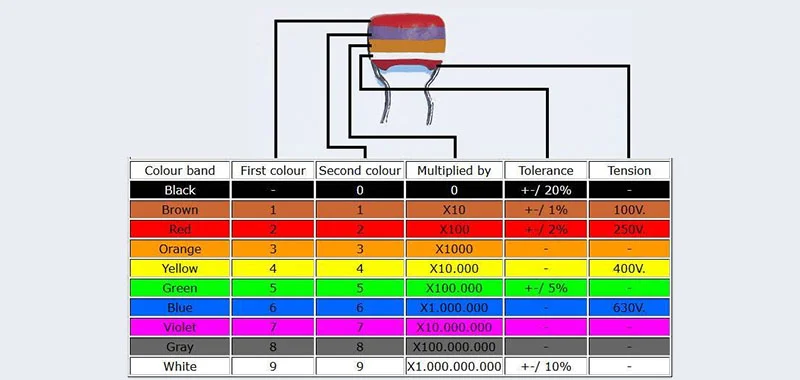
How to Read Capacitor Color Codes
Identify the Bands:
Capacitors typically have three or more color bands. The first two (or three for some capacitors) bands indicate significant digits of the capacitance value.
Determine the Multiplier:
The next band represents the multiplier, indicating how many zeros to add to the significant digits.
Tolerance (Optional):
Some capacitors have a fourth band that indicates the tolerance of the capacitance value.
Example:
Suppose a capacitor has the color bands: Yellow, Violet, Orange, and Red.
Yellow (4)
Violet (7)
Orange (Multiplier = 1,000)
Putting these together, the capacitance value is 47 x 1,000 = 47,000 pF or 47 nF.
Voltage Rating (Rarely Used in Color Codes)
Some capacitors might use additional bands or other markings to indicate voltage ratings, but this is less common. Usually, the voltage rating is directly printed on the capacitor body.
Important Notes
Unit Conversion:
Capacitance values might be in picofarads (pF), nanofarads (nF), or microfarads (μF).
1,000 pF = 1 nF
1,000 nF = 1 μF
Tolerance:
The tolerance band (if present) helps to understand the precision of the capacitor. For instance, a capacitor with a ±5% tolerance may have a capacitance value that can vary by 5% above or below the market value.
By understanding these color codes, you can quickly identify the capacitance value and possibly the tolerance of a capacitor, aiding in their correct application in electronic circuits.
Why care about How Are Capacitors Rated
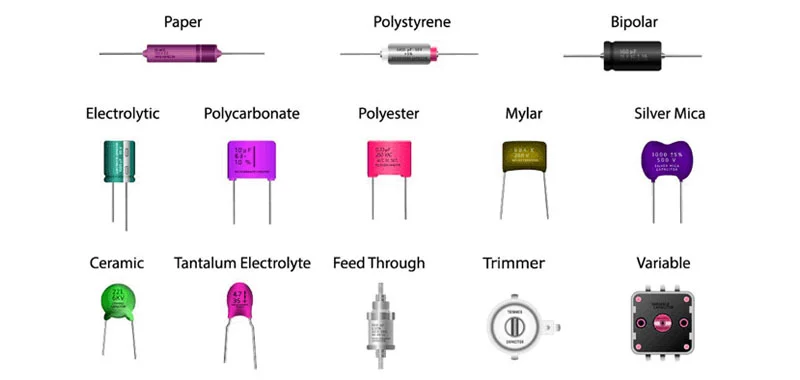
Proper Selection:
Different applications require capacitors with specific characteristics such as capacitance, voltage rating, and temperature coefficient. Knowing how capacitors are rated helps engineers and designers select the most suitable component for their application, ensuring optimal performance and reliability.
Avoiding Circuit Failure:
Using capacitors with incorrect ratings can lead to circuit failure or malfunction. For example, exceeding the voltage rating of a capacitor can cause it to break down, potentially damaging other components in the circuit. Understanding capacitor ratings helps prevent such failures.
Optimizing Performance:
Capacitor specifications like ESR and frequency response can significantly impact circuit performance. By selecting capacitors with appropriate ratings, engineers can optimize circuit performance, minimize power losses, and achieve desired frequency response characteristics.
Ensuring Safety:
Capacitors can store electrical energy and release it rapidly when discharged. Using capacitors with inadequate voltage ratings or poor temperature characteristics can pose safety risks, including the risk of explosion or fire. Properly rated capacitors help ensure the safety of both the circuit and its users.
Cost Efficiency:
Selecting capacitors based on their ratings and specifications helps avoid over-specification, which can lead to unnecessary costs. By understanding the requirements of the application and selecting capacitors accordingly, engineers can optimize cost without compromising performance or reliability.
FAQs
What are the key parameters for rating capacitors?
Capacitors are rated based on several key parameters, including capacitance (C), voltage rating (V), tolerance, temperature coefficient (TC), dielectric material, frequency response, and ESR (Equivalent Series Resistance).
How do you determine the voltage rating of a capacitor?
You determine the voltage rating of a capacitor by checking the maximum voltage it can handle without risking failure. This rating is usually printed on the capacitor and ensures it can safely operate within the circuit’s voltage limits.
Why is capacitance important in rating capacitors?
Capacitance, measured in microfarads (μF), indicates a capacitor’s ability to store electrical charge. A higher capacitance value means the capacitor can store more energy, which is crucial for various applications like filtering, decoupling, and energy storage.
What does tolerance mean in capacitor ratings?
Tolerance specifies the allowable deviation from the nominal capacitance value, usually expressed as a percentage (e.g., ±5%). It tells you how much the actual capacitance can vary from the stated value.
How does the temperature coefficient affect capacitor ratings?
The temperature coefficient (TC) indicates how much the capacitance changes with temperature variations. It is crucial for applications where the operating temperature fluctuates significantly, ensuring the capacitor performs consistently.
Conclusion
In summary, caring about how capacitors are rated is essential for selecting the right components, ensuring proper circuit operation, maximizing performance, ensuring safety, and optimizing cost-efficiency in electronic design and engineering projects.
Understanding how capacitors are rated is fundamental for anyone involved in electronic design and engineering. Properly rated capacitors ensure that circuits function efficiently, reliably, and safely. By considering key parameters such as capacitance, voltage rating, tolerance, temperature coefficient, dielectric material, frequency response, and ESR, designers can select the most suitable capacitors for their specific applications.
This not only optimizes performance and cost-efficiency but also prevents potential failures and safety hazards. Ultimately, a thorough grasp of capacitor ratings and types empowers engineers to create more effective and durable electronic systems.




















